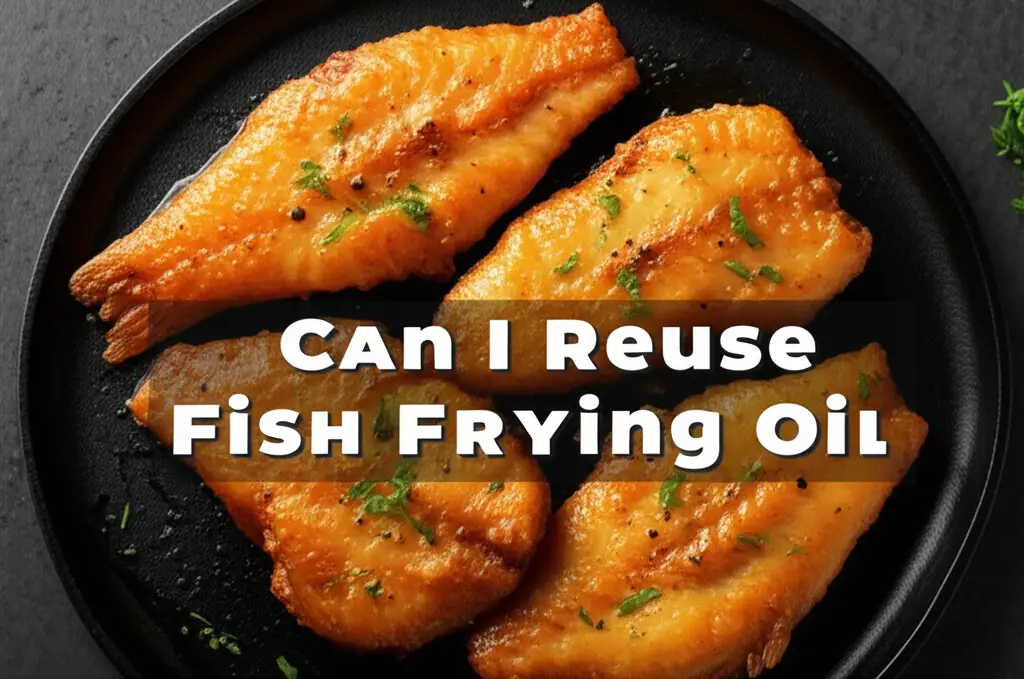· Liora Benning · Cooking & Kitchen Tips · 14 min read
Can I Reuse Fish Frying Oil

Can I Reuse Fish Frying Oil: A Practical Guide
After preparing a batch of delicious, crispy fried fish, you probably find yourself with a container of used cooking oil. A common question arises: can I reuse fish frying oil? It is a thought many home cooks have. Reusing oil seems like a good way to save money and reduce waste.
However, safety and quality are very important when reusing cooking oil. Oil changes its chemical structure when heated, especially at high frying temperatures. Understanding these changes helps you decide when it is safe to reuse your oil. This article explains how to properly handle, store, and determine the lifespan of your fish frying oil. I will guide you through the best practices for safe and delicious results.
Takeaway
- Filter Thoroughly: Always remove food particles after each use.
- Store Correctly: Keep oil in an airtight container in a cool, dark place.
- Monitor Quality: Look for changes in color, smell, and smoke point.
- Limit Reuses: Do not reuse oil too many times to ensure safety and flavor.
- Discard Safely: Dispose of old oil responsibly, never down the drain.
You can often reuse fish frying oil, but with careful considerations. Always filter it to remove food particles. Store the oil properly in a cool, dark place. Check for signs of rancidity or degradation before each reuse to ensure food safety and quality.
Understanding Oil Degradation During Frying: What Happens to Your Oil?
When you fry fish, the cooking oil goes through many changes. Heat, oxygen, and food particles from the fish all affect the oil. This process is called oil degradation. The oil breaks down over time, which changes its properties.
High temperatures cause oil molecules to break apart. This creates new compounds, some of which are harmful. Oxygen in the air also reacts with the oil, leading to oxidation. This makes the oil turn rancid faster. Small bits of fish, batter, or seasoning left in the oil also speed up this breakdown. These particles burn and decompose, adding unpleasant flavors and colors to the oil.
As oil degrades, its smoke point lowers. The smoke point is the temperature at which oil begins to smoke continuously. This smoking indicates that the oil is breaking down and releasing unhealthy compounds. Old, degraded oil also loses its ability to transfer heat evenly. This results in food that is greasy or soggy instead of crispy. Understanding these changes helps you know why proper handling is so important for reusing oil. It ensures your fried food stays delicious and safe to eat.
The Art of Filtering Used Frying Oil: Maximize Lifespan
Filtering your fish frying oil after each use is a key step. This process removes food particles and impurities. These particles are the main culprits behind quick oil degradation. They burn and decompose when reheated, which gives the oil a bitter taste.
To filter oil effectively, wait until it cools completely. Hot oil is dangerous to handle and can cause severe burns. Once cooled, pour the oil through a fine-mesh strainer lined with cheesecloth or a coffee filter. The goal is to catch all the tiny bits that settled at the bottom. I find that a good quality coffee filter works best for tiny particles.
Repeat the filtering process if you see any remaining debris. The cleaner the oil, the longer it will last. This simple step extends the oil’s lifespan. It also helps prevent unwanted flavor transfer to your next dish. Filtering is crucial for both safety and taste. Imagine preparing a delicious meal like a frying fish pie and ensuring the oil is clean for perfect results. Proper filtering means your oil is ready for its next use.
Step-by-Step Oil Filtering
- Cool the Oil: Let the oil cool completely to room temperature. This might take several hours.
- Prepare Your Setup: Place a fine-mesh strainer over a clean, heat-safe container. Line the strainer with two layers of cheesecloth or a sturdy coffee filter.
- Pour Slowly: Carefully pour the cooled oil through the prepared filter. Allow the oil to drain slowly. Do not rush this step.
- Discard Solids: Throw away the collected food particles and used filter. They contain old flavors and impurities.
- Store Clean Oil: Transfer the filtered oil to an airtight container. Keep it in a cool, dark place.
Proper Storage for Reused Frying Oil: Keeping It Fresh
Storing your filtered fish frying oil correctly is just as important as filtering it. Improper storage can quickly make good oil go bad. Oxygen, light, and heat are the main enemies of stored oil. They speed up oxidation and rancidity.
Always use an airtight container for storage. Glass jars with tight-fitting lids work well. Metal containers can also be suitable, but ensure they are clean and dry. Avoid using plastic containers if possible, as some plastics can leach chemicals into the oil over time. I prefer to use glass jars that I can easily clean.
The best place to store reused oil is in a cool, dark pantry or cupboard. Heat causes oil to degrade faster. Light also contributes to oxidation. Some people choose to store their oil in the refrigerator. This can extend its life even further by slowing down chemical reactions. However, refrigerated oil will become cloudy and solidify. It returns to its clear liquid state once it warms up to room temperature.
Ideal Storage Conditions
- Airtight Container: Use a container that seals tightly to keep out oxygen.
- Cool Location: Store oil in a pantry or cupboard away from heat sources like stoves or ovens.
- Dark Place: Protect the oil from direct sunlight or bright artificial lights.
- Refrigerator Option: For maximum lifespan, store in the fridge. The oil will solidify but will become liquid again at room temperature.
How Long Can You Store It?
The storage time for reused oil varies. It depends on the oil type, what you fried, and how well you filtered and stored it. Generally, properly filtered and stored fish frying oil can last for a few weeks up to a month. Always trust your senses before reusing it again. Smell and taste tests are your final checks.
Factors Influencing Oil Reusability: How Many Times is Safe?
The number of times you can reuse fish frying oil is not a fixed number. Several factors influence its lifespan. The type of oil you use plays a big role. Oils with high smoke points, like canola, vegetable, peanut, or sunflower oil, generally handle more reuses than olive oil. These oils are more stable under high heat.
What you fry also impacts the oil’s life. Fish, especially breaded or battered fish, leaves behind many small particles. These particles degrade the oil faster than frying plain items like potato chips. The higher the frying temperature and the longer the frying time, the quicker the oil breaks down. Using a controlled temperature, perhaps with a proper fish fryer light for precise settings, can help preserve oil quality.
The initial quality of the oil matters too. High-quality, fresh oil will last longer than oil that was already old or close to its expiration date. How well you filter and store the oil also directly affects its reusability. Skipping these steps drastically reduces the number of times you can use the oil. I find that I can usually reuse my fish oil 2-3 times for fish, maybe 4-5 times for lighter items like french fries, if I filter it carefully.
Oil Type Matters
- High Smoke Point Oils: Canola, vegetable, peanut, and sunflower oils are best for deep frying. They withstand high temperatures well.
- Lower Smoke Point Oils: Olive oil or butter brown and degrade quickly. They are not ideal for deep frying or reuse.
Food Type Impact
- Battered or Breaded Foods: These leave more crumbs in the oil. This leads to faster degradation.
- Plain Foods: Items like fries or plain vegetables leave fewer residues. This makes the oil last longer.
- Strong Flavors: Frying fish imparts a distinct flavor to the oil. Consider dedicating specific oil for fish to avoid flavor transfer to other foods.
Health and Flavor Considerations: Why Reusing Oil Matters
Reusing cooking oil involves both health and flavor considerations. As oil breaks down, it forms compounds that are not good for your health. These compounds include free radicals and polar compounds. Consuming high amounts of these substances may have negative health effects. They can contribute to inflammation and other issues. This is why it is important to know when to discard old oil. Your health should always be a priority.
From a culinary perspective, old oil impacts the taste of your food. Degraded oil gives food an off-flavor, often described as stale, rancid, or bitter. It also loses its ability to create crispy textures. Food fried in bad oil tends to be greasy and soggy. The goal of deep frying is a crisp exterior and a tender interior. Old oil simply cannot deliver this desired result. I always taste a tiny bit of my filtered oil before using it again. If it tastes anything other than clean and neutral, I discard it.
Flavor transfer is another factor. Oil used for fish will carry a fishy flavor. If you plan to fry doughnuts next, you do not want them to taste like last night’s cod. It is wise to have separate batches of oil for different types of foods. This prevents unwanted flavors from mixing. This ensures that your next dish tastes as intended, without any lingering fish notes.
Preventing Flavor Transfer
- Dedicated Oil: Keep separate oil batches for strong-flavored foods like fish or spicy items.
- Filter Meticulously: Thorough filtering helps remove odor-causing particles, but some flavor absorption is inevitable.
Health Considerations
- Harmful Compounds: Repeated heating forms unhealthy compounds in the oil.
- Smoke Point: A lower smoke point means the oil is breaking down faster. This indicates harmful substances are forming.
- Moderation: Even with careful reuse, consuming too much deep-fried food should be in moderation.
When to Discard Reused Frying Oil: Clear Indicators
Knowing when to throw out your reused fish frying oil is critical for safety and taste. There are clear signs that tell you the oil has reached the end of its useful life. Do not rely solely on the number of reuses. Always inspect the oil before you heat it up.
One of the most obvious signs is a change in color. Fresh oil is light and clear. Degraded oil often becomes much darker, sometimes even murky or brownish. This dark color indicates that many impurities and breakdown products are present. Another indicator is its smell. Fresh oil has a neutral or faint aroma. If your oil smells fishy, rancid, sour, or burnt, it is definitely time to discard it. I usually give it a sniff test before I even think about reheating it.
When you heat the oil, watch its behavior. If it starts smoking at a much lower temperature than usual, its smoke point has dropped significantly. This means the oil has broken down too much. Excessive foaming or bubbling during heating, even before adding food, is another warning sign. This foaming indicates the presence of water and other impurities. If the food fried in it becomes soggy or cooks unevenly, the oil’s quality is compromised. Finally, a bitter or metallic taste in your fried food is a definite sign to throw out the oil immediately.
Visual Cues for Discarding Oil
- Dark Color: The oil turns significantly darker than its original shade.
- Murky Appearance: The oil looks cloudy or thick, even after filtering.
- Excessive Foaming: The oil foams excessively or bubbles rapidly when heated, without food in it.
- Low Smoke Point: The oil starts smoking at a much lower temperature than it should.
Olfactory Warnings
- Rancid Smell: The oil has a sour, unpleasant, or “old oil” smell.
- Burnt Odor: Even when cold, the oil carries a strong, burnt aroma.
- Strong Fishy Smell: If the fish smell is overpowering even after filtering, it might be too strong for other uses.
Safe Disposal and Cleanup: Beyond the Frying Pan
Once your fish frying oil has reached the end of its life, proper disposal is essential. Never pour cooking oil down the drain. Liquid oil can solidify in pipes, causing severe clogs in your home plumbing and public sewer systems. This can lead to costly repairs and environmental damage. The grease binds with other debris, creating blockages.
The best way to dispose of used cooking oil is to let it cool completely. Once solid or cooled, transfer it into a non-recyclable, sealed container. Empty milk cartons, plastic jugs, or coffee cans work well for this. Seal the container tightly to prevent leaks. Then, place the sealed container in your regular trash bin. Some communities also have recycling programs for used cooking oil. Check with your local waste management services for specific guidelines.
If you accidentally spill oil, cleanup is important. For instance, if you get oil on your carpet, you need specific methods to remove it effectively. Learning how to get peanut oil out of carpet or general oil spills helps maintain a clean home. Similarly, if oil residue gets into your appliances, methods like those for how to get oil out of a washing machine become relevant. Taking care with oil disposal keeps your home clean and your environment safe.
Steps for Proper Oil Disposal
- Cool It Down: Let the oil cool completely to room temperature.
- Containerize: Pour the cooled oil into a non-recyclable, sealed container. Examples include milk cartons or plastic bottles.
- Seal Tightly: Make sure the container is securely sealed to prevent leaks.
- Trash It: Place the sealed container in your regular household trash.
- Recycle (If Available): Check if your local recycling center accepts used cooking oil.
FAQ Section
How many times can I reuse fish frying oil?
You can generally reuse fish frying oil 2-3 times for fish. For lighter items like plain french fries, you might get 4-5 reuses. The exact number depends on the oil type, what you fried, and how well you filter and store it. Always check the oil’s condition before each reuse to ensure safety and quality.
What are the signs that my frying oil is bad?
Signs of bad frying oil include a dark, murky color, a rancid or burnt smell, excessive smoking at low temperatures, and persistent foaming. If your food comes out greasy, soggy, or tastes bitter, the oil is also compromised. Always trust your senses.
Should I refrigerate reused frying oil?
Yes, refrigerating reused frying oil can extend its shelf life. Cold temperatures slow down the oil’s degradation process. The oil will become cloudy and solidify in the fridge, but it will return to its liquid state when warmed. Store it in an airtight container for best results.
Can I mix old and new frying oil?
It is generally not recommended to mix old and new frying oil. The degraded compounds in old oil will accelerate the breakdown of the fresh oil. This reduces the lifespan of the new oil. For best results and food safety, use either fresh oil or a batch of previously used, but still good, oil.
How do I properly dispose of used frying oil?
Let the oil cool completely. Pour it into a non-recyclable, sealed container like an empty milk carton or plastic jug. Seal it tightly and place it in your regular trash. Never pour oil down the drain, as it can cause severe clogs and environmental damage.
Does reusing fish frying oil affect the taste of other foods?
Yes, reusing fish frying oil will impart a fishy flavor to other foods. Oil absorbs flavors from the food cooked in it. If you plan to fry different types of food, it is best to keep separate batches of oil. This prevents unwanted flavor transfer and maintains the taste of your dishes.
Conclusion
Reusing fish frying oil can be a practical way to save resources and minimize waste. However, safety must always come first. By following proper filtering and storage techniques, you can extend your oil’s life while ensuring your food remains delicious and healthy. Remember to always cool the oil completely before handling it. Filter it thoroughly to remove any food particles. Store the filtered oil in an airtight container in a cool, dark place.
Regularly check your reused fish frying oil for signs of degradation. Look for changes in color, smell, and how it behaves when heated. If the oil smells rancid, looks too dark, or smokes excessively, it is time to discard it. Never risk your health or the taste of your food. When the oil has reached its limit, dispose of it responsibly in a sealed container in the trash. Never pour it down the drain. By using these simple yet effective steps, you can confidently reuse your fish frying oil and enjoy great fried meals every time.





